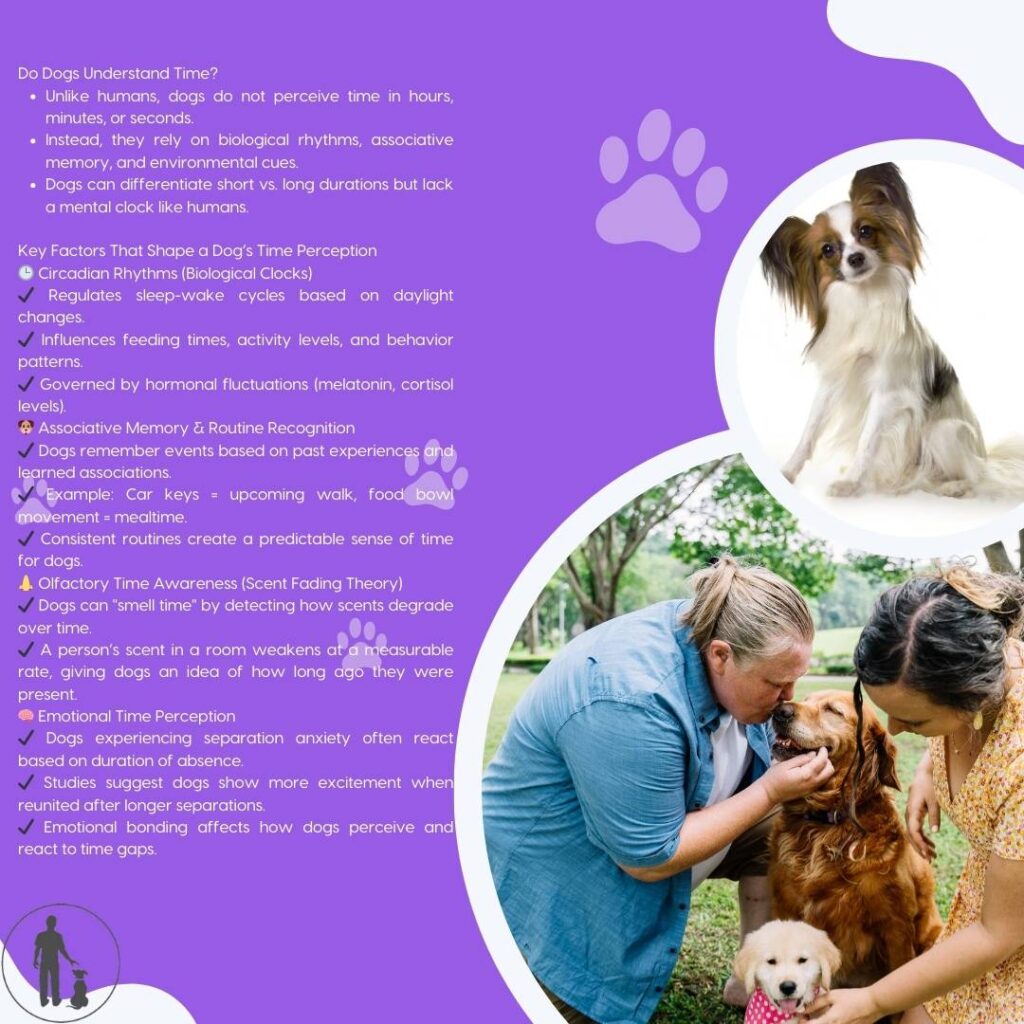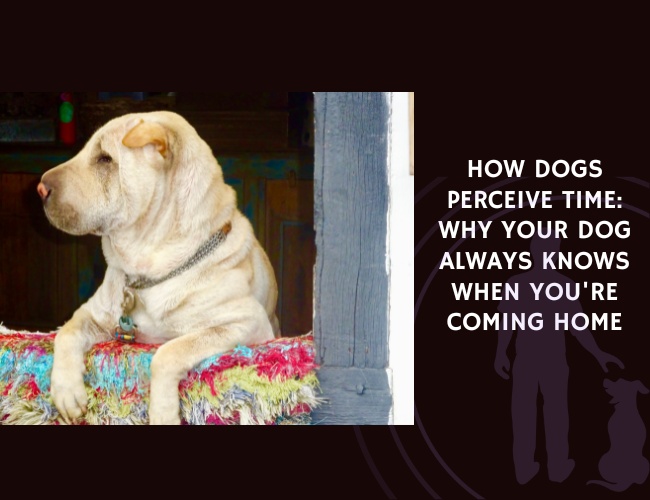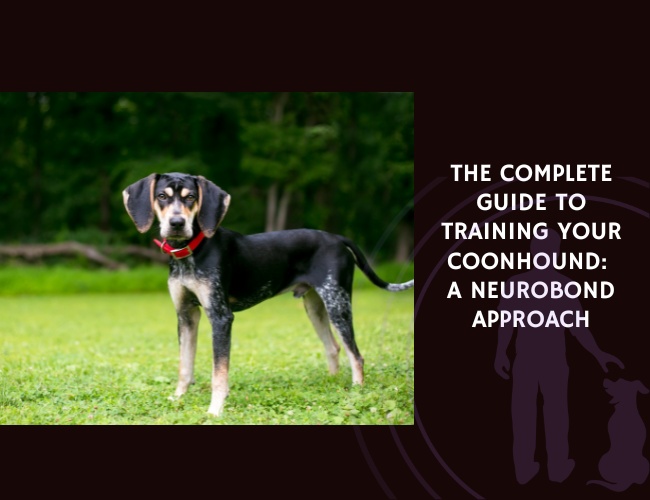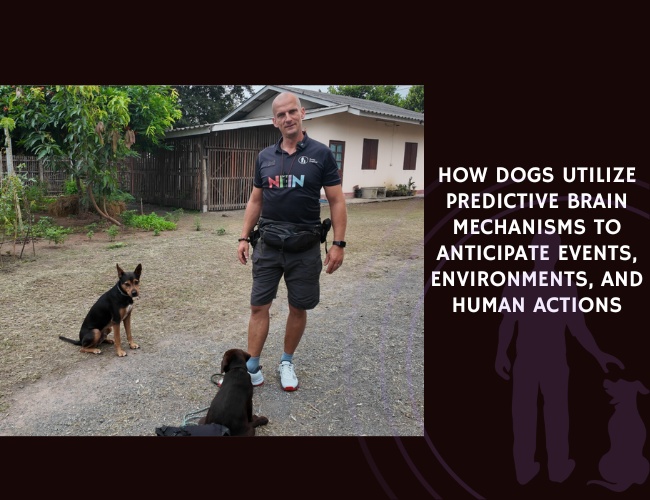Understanding Canine Time Perception
Dogs experience time differently from humans, primarily through biological rhythms and environmental cues. This distinction is crucial for understanding their behavior and emotional responses, especially in relation to daily activities and routines. Let’s dive deeper into how dogs perceive time and what mechanisms govern their temporal awareness.
Biological Rhythms and Environmental Cues
Dogs rely on their biological rhythms, or circadian rhythms, to navigate their day-to-day lives. These internal clocks help them anticipate routine events such as feeding times, walks, and play sessions. Unlike humans who can measure and conceptualize time abstractly through hours and minutes, dogs use their experiences and consistent routines as markers.
Circadian rhythms play a vital role in regulating canine behavior. These 24-hour cycles of physiological processes influence when dogs feel hungry, sleepy, or energetic. For instance, a dog might become excited when its internal clock signals that it is close to the time its owner typically returns home from work. This anticipation showcases their ability to instinctively understand time based on routine cues.
The Role of Circadian Rhythms in Behavior
Circadian rhythms are not just about sleep and wakefulness; they govern a range of activities and behaviors in dogs. For example, dogs tend to have peak activity periods that align with their natural feeding or exercise schedules. If a dog is accustomed to a particular routine, any deviation can lead to confusion or anxiety.
Research indicates that dogs adjust their behavior in anticipation of these routine events. Dogs can sense the time of day relative to events in their environment and respond accordingly. An example is a dog who starts to get restless or anxious close to the time when their owner arrives back home. This behavior aligns with their internal circadian rhythms and learned experiences, emphasizing how pivotal these rhythms are in a dog’s life.
Instinctual Understanding vs. Human Abstract Concepts
One of the significant differences between humans and dogs is in the conceptualization of time. Humans have the ability to think about time abstractly, considering past, present, and future events in a linear fashion. This cognitive capability allows us to plan and make long-term decisions.
Conversely, dogs do not have this abstract understanding of time. Their perception of time is more instinctual and immediate. They live in the moment, with their sense of the past and future closely tied to associative memory. For dogs, time is experienced through:
- Biological rhythms: These natural cycles help dogs predict daily activities.
- Environmental cues: Changes in light, temperature, and habitual events signal time changes.
- Associative memory: Dogs link specific cues, such as the sound of a car arriving, with the result (owner’s return).
Environmental Cues and Associative Learning
Dogs are adept at using environmental cues to form associations, which play a critical role in how they perceive time. For example, the duration of a scent trail or the position of the sun can serve as time markers for dogs. These cues help them understand when certain events are likely to occur.
Associative learning ties various sensory inputs to specific outcomes. A dog might recognize that the rustling of a food bag indicates feeding time or that the jingle of car keys means an imminent car ride. These associations help dogs develop a sense of temporal patterns without abstract reasoning.
Understanding how dogs perceive time through biological rhythms and environmental cues offers valuable insights into their behavior. Recognizing these temporal awareness mechanisms can help improve routines, enhance training methods, and address behavioral issues such as separation anxiety. This chapter’s insights pave the way for exploring the more intricate aspects of dogs’ temporal awareness and its implications in their emotional and cognitive development.
The Science Behind Dogs’ Temporal Awareness
Associative Memory vs. Episodic Memory
Understanding how dogs perceive time requires an exploration of associative memory and episodic memory. Episodic memory, which involves recalling specific events from the past, is more developed in humans than in dogs. Dogs, on the other hand, primarily rely on associative memory. This form of memory allows them to link certain cues or signals (like the sound of a leash) with specific outcomes (such as going for a walk).
Although dogs may not remember events in the same detailed manner that humans do, they can still recall past experiences through associations. This ability to link environmental cues with experiences helps dogs anticipate and react to their environment in an instinctual manner. For example, a dog might not recall the exact time they got last fed, but the sound of food being prepared can trigger the memory of a past meal, influencing their behavior in the present.
Neural Pathways and Brain Structures
Neuroscientific research has highlighted specific brain structures involved in processing time. In dogs, certain neural pathways and brain structures are instrumental in forming memories and anticipation. These pathways allow dogs to link past experiences with future expectations, which plays a key role in their understanding of time.
Functional MRI (fMRI) studies have provided insights into how dogs process temporal information. These studies show that dogs use similar but less complex neural mechanisms compared to humans. By examining how different parts of the brain activate in response to time-related cues, researchers can better understand the cognitive processes involved in canine time perception.
Recognizing and Responding to Time Intervals
Dogs have shown a remarkable ability to recognize and respond to different time intervals, which plays a significant role in their daily lives. Behavioral studies have demonstrated that dogs can anticipate events based on learned time intervals. For instance, if a dog gets consistently walked around the same time every day, it is likely to exhibit behaviors indicating anticipation as that time approaches. This ability to predict routine events is closely tied to associative memory.
Moreover, dogs display different behavioral responses based on the length of time their owners are absent. Dogs tend to react with varying levels of excitement or anxiety depending on whether their owners have been gone for just a few minutes or several hours. This differentiation demonstrates an understanding of temporal patterns and indicates that dogs have a subjective sense of time.
The combination of associative memory, neural pathways, and learned experiences equips dogs with a unique ability to perceive time. It underscores the importance of routines and environmental consistency in shaping canine behavior and well-being.
As we continue to explore the science behind canine time perception, it becomes evident that dogs’ understanding of time, although different from humans, is deeply rooted in their biology and experiences. This knowledge is crucial for enhancing training approaches and improving the overall welfare of our canine companions.
Up next, we will delve deeper into the strong connection between a dog’s sense of time and the potency of their olfactory capabilities.

The Power of Scent in Time Perception
How Dogs Use Scent Degradation to Gauge the Passage of Time
Dogs are renowned for their extraordinary sense of smell, which far surpasses that of humans. This olfactory prowess extends to their ability to perceive time. Research suggests that dogs may use scent degradation to determine how much time has passed since a person or an animal was present. As odors dissipate and change over time, a dog can interpret these shifts, akin to reading a clock.
The Connection Between Olfactory Cues and Memory Formation
Dogs rely heavily on their sense of smell to form and recall memories. Olfactory cues are instrumental in the process of associative memory formation, where a dog links a particular scent with an event or experience. For instance, the familiar scent of their owner can evoke memories of past interactions and predict behaviors, like anticipating a walk or mealtime.
Environmental odors also play a crucial role in helping dogs remember past events. These scents can trigger memories associated with specific experiences. For example, the lingering smell of a visitor can remind the dog of the encounter even after the person has left.
How Environmental Odors Help Dogs Understand Past Events and Anticipate Future Ones
Dogs use environmental odors to navigate their world and understand temporal sequences. They can follow scent trails to find food or locate other animals. This ability indicates that dogs piece together temporal information based on the degradation and intensity of smells.
Through learned experiences, dogs also develop an understanding of future events based on environmental odors. For example, a dog might become excited about the prospect of playtime when they smell their owner’s scent on a leash, associating it with previous enjoyable walks.
Practical Implications for Training and Dog Welfare

Our understanding of how dogs perceive time through scent can greatly influence training methods and enhance overall canine welfare. By leveraging olfactory cues, trainers can create more effective training regimes tailored to the dog’s natural abilities. Additionally, recognizing the dog’s reliance on scent degradation and associative memory can help mitigate issues like separation anxiety by creating comforting and consistent environments based on familiar smells.
This deep dive into the power of scent in time perception underscores the importance of olfactory cues in a dog’s understanding of their environment, past experiences, and future events. This insight into canine cognition can foster stronger bonds between dogs and their owners and illuminate approaches for better managing their behavior and well-being.
Routines and Time Recognition
The Importance of Daily Schedules in Shaping a Dog’s Understanding of Time
Dogs thrive on routine, and their ability to predict future events largely depends on their understanding of daily schedules. Just like humans rely on clocks to manage their day, dogs depend on established routines to navigate time. Consistency in feeding, walking, and playtime allows dogs to form reliable patterns, making their day predictable and reducing anxiety.
For instance, if you feed your dog every day at 7:00 AM, they will soon start to anticipate this event as the time approaches. This anticipation is not due to them reading the clock but rather recognizing the sequence of daily events. This instills a sense of normalcy and security, which is crucial for their well-being.
How Dogs Anticipate Events Based on Learned Time Intervals
Dogs have an incredible ability to learn and respond to patterns. They use associative memory to link specific cues, such as the sound of food being prepared, with the outcome of being fed. This means that even if the exact time shifts slightly, the sequence of events leading up to it remains constant, helping dogs predict what comes next.
Research has shown that dogs can be trained to perform tasks at specific intervals, showcasing their ability to understand time-based patterns. For example, a dog might learn that after the evening news, it is time for a walk and start pacing near the door as the news ends. This behavior is a direct result of the dog’s environment conditioning them to respond to specific cues, creating a structure that helps them feel secure.
The Relationship Between Routine Consistency and Behavioral Patterns
Consistency is key when it comes to shaping a dog’s behavior. When routines are erratic, dogs can experience confusion and anxiety, leading to undesirable behaviors such as excessive barking or destructive chewing. A consistent routine, on the other hand, helps foster positive behavioral patterns and provides a sense of stability for the dog.
For example, a dog that knows it will be walked every morning after breakfast is less likely to engage in destructive behavior out of boredom because it understands that its exercise time is coming. This predictability helps dogs manage their energy levels and adapt to their environment confidently.
Environmental and Contextual Cues
Dogs also use environmental cues to understand the passage of time. The changes in light throughout the day, household activities, and even the presence of certain members of the household can all serve as indicators for dogs to anticipate what comes next. For instance, a dog may start getting excited as soon as you put on your shoes because it has learned that this usually means it is time for a walk.
Environmental odors also play a significant role in their routine. Dogs are highly reliant on their sense of smell, and changes in the environment’s scents can inform them about time-related events such as the return of a family member. Recognition of these patterns helps dogs anticipate and react accordingly, creating a cycle that reinforces their understanding of time.
Brief Transition
Understanding the importance of routines and the way they shape a dog’s perception of time can significantly impact the approach to training, behavior, and overall well-being. As we explore further, we’ll delve into the nuances of how separation and the duration of absences affect canine behavior.

Separation and Time Awareness
How Dogs Differentiate Between Short and Long Absences
Dogs have an intriguing ability to distinguish between shorter and longer periods spent apart from their owners. This differentiation is apparent through their varied behavior during reunion moments. For example, a dog might remain relatively calm after a brief absence but show signs of intense excitement or distress after a longer one. This behavioral divergence is a strong indicator of their underlying temporal awareness.
Recent studies measuring dogs’ excitement levels upon their owners’ return reveal that dogs exhibit heightened enthusiasm when their owners have been away for extended periods. Conversely, shorter absences might invoke less dramatic reactions. These observations suggest that dogs have a way of sensing the passage of time, even if they do not understand it in the abstract way humans do.
The Connection Between Separation Anxiety and Time Perception
Separation anxiety is a common issue among dogs and can profoundly impact their well-being. This anxiety often stems from a dog’s acute awareness of time and their emotional response to an owner’s absence. Dogs that suffer from severe separation anxiety exhibit distressing behaviors such as excessive barking, destructive chewing, and even attempts to escape.
The anticipation of their owner’s return can elicit significant emotional responses in dogs prone to anxiety. They begin to associate certain cues with their owner’s absence and subsequent return. For example, if a dog becomes anxious each morning as the owner prepares to leave, this suggests the dog has developed a temporal pattern linked to those specific cues and times. Such associations can make managing and alleviating separation anxiety challenging but also offer avenues for therapeutic interventions and behavior modification.
Behavioral Changes Based on Duration of Owner Absence
Dogs’ reactions to their owners’ absences vary considerably based on the duration of the separation. Several factors contribute to these behavioral changes:
- Short Absences: A brief separation, such as a short trip to the grocery store, might not significantly impact a dog’s behavior. They may remain relatively calm, engage in idle activities, or nap until their owner returns. The dog trusts that their owner will be back soon, as the brief absence does not cause distress.
- Moderate Absences: When owners are away for a few hours, dogs might display a mix of calm and mild anxiety. They may wait by the door for extended periods or intermittently check the windows. Upon their owner’s return, dogs usually show moderate levels of excitement, indicating they have been aware of the prolonged absence but were not excessively distressed.
- Long Absences: Extended separations, such as when owners leave for a full workday or longer trips, significantly affect a dog’s behavior. Dogs might display notable anxiety, restlessness, or even destructive behavior. Their emotional state intensifies as the time interval extends, leading to dramatic expressions of excitement or relief when their owners finally return.
By understanding these variations in canine behavior associated with the length of time their owners are absent, pet owners and trainers can develop more effective strategies to ease separation anxiety. Implementing structured routines, consistent training, and employing temporal cues can help improve canine behavior and overall welfare.
Moreover, this knowledge can empower dog owners to better anticipate and address their pets’ needs, contributing to a harmonious and stress-free environment for both.
By aligning training and care practices with an increased understanding of a dog’s time perception, we can provide better support and foster an improved relationship between dogs and their owners.
Practical Applications and Training Implications
Understanding how dogs perceive time is a valuable tool for dog owners and trainers. By utilizing this knowledge, we can improve training methods, manage separation anxiety, and boost overall canine welfare. This chapter delves into practical strategies and applications of canine temporal awareness.
Improving Training Methods
Knowing that dogs rely on associative memory and circadian rhythms to understand time, trainers can tailor their approach to align with a dog’s natural patterns.
- Consistent Training Schedules: Establishing a regular training time each day helps dogs anticipate learning sessions, making them more receptive.
- Short, Focused Sessions: Dogs retain information better in short bursts. Frequent, brief training intervals can enhance learning and reduce stress.
- Positive Reinforcement: Immediate rewards following desired behaviors leverage dogs’ associative memory, reinforcing the connection between action and outcome.
Managing Separation Anxiety
Separation anxiety is a common issue that many dogs face. Understanding their time perception helps develop strategies to alleviate this anxiety.
Structured Routines
Dogs thrive on routine. A consistent daily schedule provides predictability and security, reducing anxiety when owners leave.
- Predictable Absences: Regularize departures and returns to create less anxious anticipation.
- Pre-Departure Cues: Establish simple routines before leaving, signaling departure without causing stress.
- Gradual Desensitization: Gradually increasing the duration of absences acclimatizes dogs to being alone, easing long-term anxiety.
Environmental Enrichment
Engage dogs with activities and objects that occupy their time, reducing stress during absences.
- Puzzle Toys: Treat-dispensing puzzles and chew toys provide mental stimulation and distraction.
- Scent-Based Activities: Hide treats around the home to encourage sniffing and exploration, tapping into their olfactory capabilities.
Enhancing Behavior and Welfare
By leveraging time-based cues, owners can foster positive behavior and improve overall welfare.
Time-Based Cues
Dogs can learn to associate specific times of day with certain activities, aiding in creating a well-behaved and content pet.
- Feeding Times: Regular feeding schedules help dogs anticipate meals, reducing anxiety related to food.
- Exercise Routines: Consistent walk and play times contribute to a balanced lifestyle, promoting physical and mental health.
- Training Signals: Use distinct cues for training sessions, such as a specific sound or word, to create clear associations.
Regular Bonding
Spending quality time with dogs strengthens the human-animal bond, contributing to their emotional well-being.
- Interactive Play: Engaging in interactive games like fetch or tug-of-war fosters trust and provides an outlet for energy.
- Affectionate Interactions: Regular petting, grooming, and calm interactions reassure dogs, reducing stress.
By understanding and applying the principles of canine time perception, we can create a harmonious and healthy environment for our pets. This knowledge is essential not just for training and managing anxiety but also for enhancing their everyday lives through structured routines and enrichment activities.










